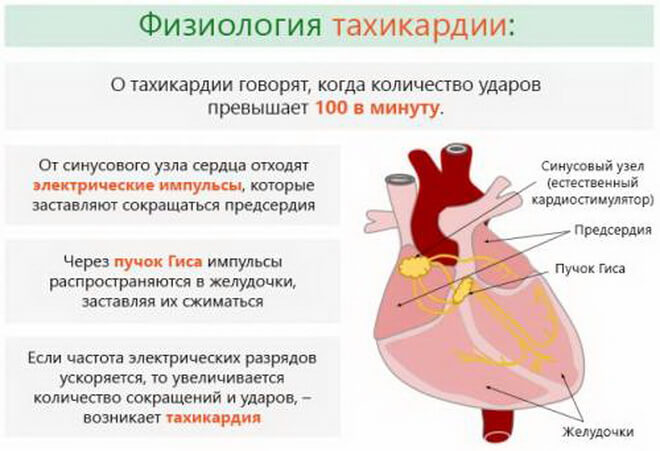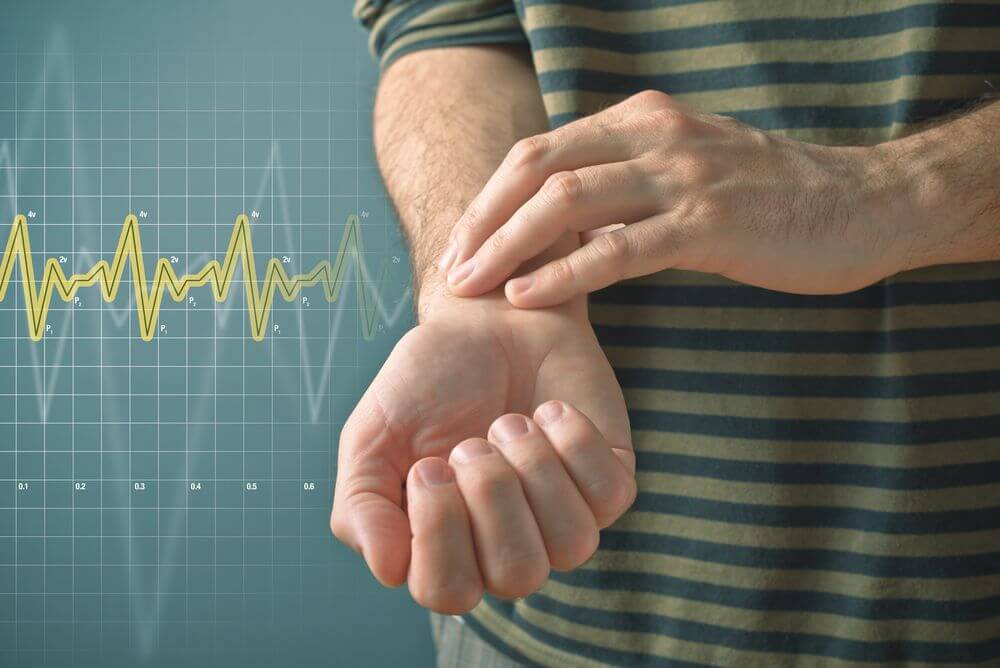Extreme tachycardia
Author Ольга Кияница
2017-11-14
Extreme tachycardia is often a physiological reaction of the body to very strong external stimuli. Such a violation of the rhythm may develop at different ages and does not depend on sex.
In some cases, extreme tachycardia may be a critical condition requiring immediate medical attention.
The use of diagnostic tooling methods often does not work, because it is necessary to react quickly and to help the patient.The only thing to remember is to firstly call an ambulance as well
after already trying to improve the well-being of the victim.
Video Tachycardia
Description of extreme tachycardia
With a person, various extreme situations can occur, which will lead to the development of tachycardia. The mechanisms of rhythm disturbance are different, but basically all of them are aimed at preserving vital organs. Similar mechanisms are still called compensatory.
- The activation of the sympathetic system leads to an increase in heart rate. This is due to the stimulation of receptors by a mediator like norepinephrine, which contributes to an increase in heart rate.
- During an unusual incident, a person is thrown into the blood of adrenaline, under which the vessels are narrowed and the heartbeat rises.
- Traumatic and wound lesions result in loss of large amounts of blood, which also affects the frequency of heart attacks. Such a compensatory reaction is aimed at repairing the oxygen deficit in organs and tissues.
What is the risk of extreme tachycardia? First of all, such critical conditions as fibrillation of the ventricles. Precisely injuries and various injuries lead to an increase in heart rate and if there is any organic damage in the myocardium, then the risk of heart failure is high.
Symptoms of extreme tachycardia
Extreme tachycardia is characterized by an increase in the frequency of cardiac contractions to critical rates. In adults, this is an average of 150 bpm / min, and in children aged 6-10 years - from 120 bs / min and above. Much depends on human endurance, while women are more sensitive to tachycardia than men, and children and the elderly can withstand a slow heartbeat than the adults.
True signs indicating that a person has tachycardia:
- First, the heartbeat is defined as intensified. That is, if a person is able to feel, then he points to such symptoms as "the heart jumps out of the chest", "the heart beats", "the heart trembles". All this at once should lead to the thought that there was an extreme tachycardia.
The term extreme tachycardia is not universally recognized and one that has entered the International Classification of Diseases. It is used to accurately describe the tachycardia, which by its development has reached extreme indicators.
- Secondly, the pulse is noticeably more frequent. This indicator can be checked by the patient himself or people close to him, if the victim is not able to show initiative.

- Third, the pulsation of the carotid artery is clearly pronounced on the neck, which is well felt when one or both hands are feeling.
The above features are characteristic of all types of tachycardia, including extreme. In addition, you may experience shortness of breath, dizziness, heart pain, and a sense of fear that will indicate an organic lesion of the heart.
What is the risk of extreme tachycardia? First of all, the body stops receiving oxygen in the required volume. Any critical situation increases these requests, especially the heart muscle, so developing tachycardia, which in the absence of assistance can lead to heart failure.
Causes of extreme tachycardia
There are many different exposure factors that can cause extreme tachycardia. First and foremost, these are injuries and injuries of varying degrees of severity. The higher the degree of blood loss, which accompanies the damage, the more pronounced tachycardia.
A number of critical states, in the form of shock, collapse, are capable of raising the heart rate to extreme rates in the shortest possible time. Also, patients with various organic lesions of the heart (especially with valve dysfunctions) become subject to palpitations with high values.
Types / photos of extreme tachycardia
The most formidable form of tachycardia, which can develop in extreme cases, is fibrillation of the ventricles or ventricular tachycardia. In the absence of treatment, this condition quickly becomes an asystole, that is, a heart stop.
There are other less dangerous conditions, which under unfavorable conditions are capable of switching to ventricular fibrillation:
- Sinus tachycardia, in which the activation of the sinus node is noted.
- Ectopic tachycardia, characterized by hyperactive status of different parts of the heart.
In most cases, whatever form of extreme tachycardia does not occur, it is a temporary, acutely violent rhythm disorder that should not be left to the attention of the patient and people close to him.
Diagnosis of extreme tachycardia
If possible, a standard electrocardiogram can be performed immediately, which will help to accurately determine the shape of the tachycardia. For this purpose, the frequency of heart rate, the amplitude and duration of the main teeth and intervals are estimated. Other diagnostic methods at the hospitalization stage are generally not available.

In hospital conditions, refinement studies can be performed in the form of echocardiography, magnetic resonance imaging of the heart, radiography of the chest organs, etc. The absence of an explicit cause of tachycardia promotes the use of specific diagnostic methods and various laboratory tests.
Treatment and prevention of extreme tachycardia
It all depends on the main cause of the appearance of extreme tachycardia. In the event of injuries, injuries and other injuries, the first aid is to stop the bleeding. Further, the therapy is carried out taking into account the type of lesions and in the case of extreme tachycardia or atrial fibrillation, defibrillation is performed.
With sinus or focal tachycardia, it helps with cold water washing, breathing exercises using deep breath and exhale. It is also important to try to calm down before the doctor arrives, for which you can drink a sedative or at least take valodol.
There is no specific prevention of extreme tachycardia, as it is not possible to prepare in advance for this condition.Unless people who are aware of their heart disease should be more cautious with long journeys, crossings, and intensified physical exercises.

Мне помогает блокатор адреналина- анаприлин 10. Но можно ли его принимать долгосрочно, например 1 таб. каждый или через день?
Евгений, долгосрочный прием анаприлина возможен, но нужен ли он? Например, после инфаркта миокарда врач может порекомендовать долгосрочное профилактическое лечение анаприлином. К тому же препарат нельзя резко отменять, только постепенно, чтобы не возникли побочные действия.
Чи можуть забрати у армію з экстремальной тахикардии?